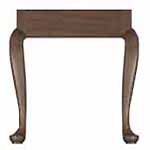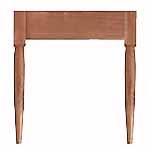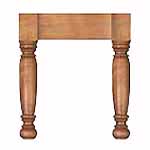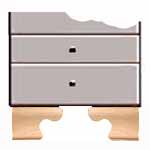Fully Custom / Period Drawer Cases:
If you can dream it up, I can find a way to make it. (Probably) We will sort out what you want very carefully with e-mails back and forth and phone chats. (I like to make sketches and email them -but you may need Adobe Acrobat to read /see them.) Think of the following as a guide. It offers some ideas you might not have thought of and gives us some common vocabulary -so we can be assured we understand each other.
For the sake of organizing the process, consider it all as a series of ordered steps. Please give it a read. It will save us both some time and confusion. Quite likely it will also get you something that absolutely DELIGHTS you.
For the sake of organizing the process, consider it all as a series of ordered steps. Please give it a read. It will save us both some time and confusion. Quite likely it will also get you something that absolutely delights you.
![]()
STEP 1 Decide how big you want your drawers to be.
This diagram will help, but to do thejob right, you need to break out a ruler or tape-measure.
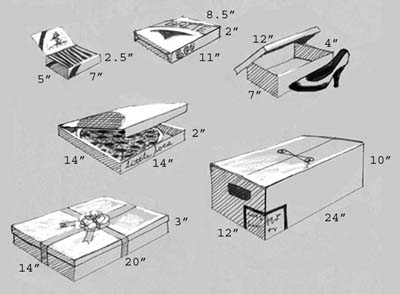
![]()
STEP 2 How many drawers do you want?
Some thoughts & guidelines....
More is better -collections grow. Yes -this allows me to sell more stuff, but if I was really all that selfish I'd suggest only buying what you needed right now, knowing full well that I'd be selling you another case in a year or two. (Come to think of it -you really ought buy only what you need right now.)

Ordinarily, the drawers are -or can be made swappable, but bigger drawers at the bottom is nice. Moderately graduating the drawer heights is even better.

If you want -and are willing to pay for it- we can do split drawers -they tend to look best in wider cases.


Tall and narrow is better'n short and fat -unless you want to put stuff on top of the case -or unless you want it that way. (But wide shallow drawers are problematic, particularly for heavy items. Wide is for your sweaters -not so much for your rock collection)
![]()
STEP 3 What species of wood do you want?
Boy is this a can of worms. Where to begin? I make my modest living with wood -know the stuff intimately. I like oak. But I also like mahogany with brass, and maple with jet. Built a lot of houses with good old Douglass fir. Wonderfully tough stuff Doug-fir -but not all that pretty.
So here is what I say on selecting wood. Oak, walnut, maple, and cherry are the most common hardwoods used in American furniture. If you want something exotic, I can probably find it. If you don't know what you want, look around, find something you like, and then find a good-old-boy, (or girl) and ask what it is. Finding the person who knows what wood is what may prove to be the hardest part.
If you still don't know -you can't go wrong with oak.
Then we come to the matter of finish. This is an even bigger can of works. Look around more. Ask more questions. Personally, I like my wood to look like wood -no stain and no thick top-coat that covers the texture. The warm glow of shellac & a little wax that makes it nice for the fingertips, and I'm happy. And unless you tell me differently, this is probably what you will get out of my shop.
![]()
STEP 4 What sort of drawer mechanism do you want?
Not to put too fine a point on it, let's consider it from least to most expensive.
 Museum-style: These drawers have an oversize bottom that easily slides in and out of a slot in the side of the case. There is an added advantage in that they can be swapped around easily and you can change two shallow drawers for one deeper one, or vise-versa. Museum drawers are full overlay -this means that the drawer front covers all the case when the drawer is closed.
Museum-style: These drawers have an oversize bottom that easily slides in and out of a slot in the side of the case. There is an added advantage in that they can be swapped around easily and you can change two shallow drawers for one deeper one, or vise-versa. Museum drawers are full overlay -this means that the drawer front covers all the case when the drawer is closed.
![]()

Partitioned drawers: Each drawer lives in it's own little cubbyhole. Easily removed and replaced, but you can't swap the sizes around. Also the drawer is prettier -cleaner & simpler- when it comes out of the case. The partition -shelf- can be visible or not -but the rest of the case -it's front edges- will show.
![]()
 Mechanical glides: The smoothest sliding way to go -the drawer actually rolls on ball-bearings. These drawers carry the heaviest loads and can be made such that the drawer comes entirely out of the case without falling on your foot. Bad news -they do not allow for easy drawer removal easily and they are EXPENSIVE.
Mechanical glides: The smoothest sliding way to go -the drawer actually rolls on ball-bearings. These drawers carry the heaviest loads and can be made such that the drawer comes entirely out of the case without falling on your foot. Bad news -they do not allow for easy drawer removal easily and they are EXPENSIVE.
![]()
STEP 5 How about a fancy top of some sort?
There are a huge number of wonderful & confusing options for the to of your case. Here again -I go from the least to most expensive.
Trim-top add-on:
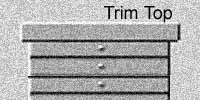
This is the simplest and perhaps the most gracious option. This is where I put the prettiest piece of wood. A trim-top can also be made to act as an operable lid (see below).
![]()
Crown top add-on:

A slightly more formal look, the crown top is a classic. It adds about 3 inches to the height of the drawer case, and 3 inches to the width, but it can be tricked up with dentils & roping, or simplified to just a few facets. It is most appropriate for a tallish case.
![]()
Federal top add-on:
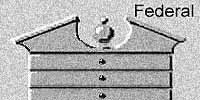
This top is for a very tall case and a very formal setting. It's literally "over the top" but in the right place -it would be the focus of the room.
![]()
Operable lids:
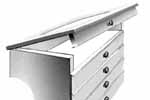
Consider the top as a lid that opens upward. This case has a false drawer-front that is attached to the lid, -looks like a regular drawer when it's closed. The space below the lid can be lined with velvet. This gives it a special feel of luxury. The lid may also actually be a window so whatever you tuck into the top is safely on display. Here is a case for a knife collector with a hinged lid & false drawer front.
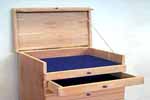
This top opens too, but does so over a regular drawer. Also gives you some idea of what display window might look like. There another possibility -having the top open over a space with a false drawer front permanently attached to the front of the case. The glass could also be a mirror on the inside of a solid lid. Have a look at this poker chip case I made with this sort of lid and drawer.
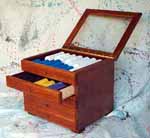
How about a secrete compartment? Perhaps a crown-molded top with a secrete compartment? Or maybe a display case with glass on three sides and the top?
![]()
STEP 6 What about the bottom?
The base of your drawer case may prove to be the most important decision you need to make. Think of the base as the foundation. Sort of sets the mood for the whole thing. Sets it off from the ordinary too.
![]()
The simplest choice is little felt pads and you put it on the floor or on another piece of furniture or countertop. But even then, little wood blocks make nice feet. Make it easier to get your fingers under it to pick it up if nothing else. Have another (close) look at the poker chip case.

![]()
Or I can make a simple toe kick. This gives the drawer case it sort of a modern built-in look. Keeps floor dirt out of the bottom drawer and -if it's big case- it will save your toes as well!
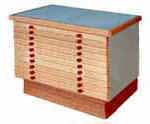
![]()
Moving up the complexity (and price) scale is to select simple Hepplewhite / Contemporary legs that bolt to the side of the case. These legs -and the ones with an apron that follows, have the advantage of being whatever height you want. (The period legs below come in a wide variety of heights, but they come the way they come.)
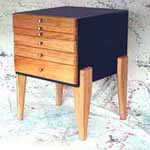
![]()
The next level up is also Heppelwait legs, but with an apron. Think of this as a little table just for the drawer case.
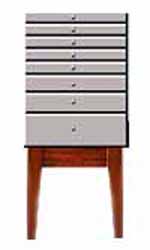
![]()
The last word and most elegant choice is to select period legs and apron for your case. They are 16" tall and solid oak to match the drawer fronts. They can be finished to match the drawers and to suit your home.
Queen Ann:
Shown in walnut stain.
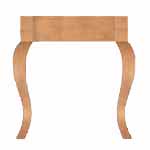
Cabriole:
Maple in honey stain.
Shaker:
Alder in medium stain.
Sheraton:
In pecan stain
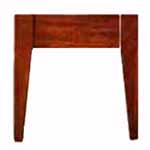
Heppelwhite:
Shown in deep mahogany
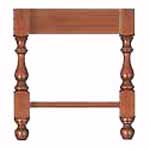
William & Mary:
In mahogany stain
(May have a shelf below)
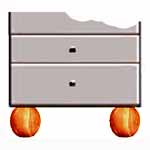
Bun-Feet:
Fruitwood stain
4 inches high
Ogee Feet:
Maple with a clear poly finish.
4 1/2 inches high
(Lousy illustration -they look great on my 24" wide cases.)
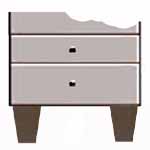
Tapered Feet:
Flat black finish
5 1/2 inches high
![]()
STEP 7 Ponder some other miscellaneous options.
File Drawer: If your collection is particularly historic, valuable, or complicated, you may do well to consider a file drawer at the bottom of the case for your documentation, insurance papers, pictures etc.
Lock: I have to say that locks only serve to keep the honest people out. Someone wants into a wood drawer case -ain't going to take 'em long to bust in. But for some collections and certain circumstances -a lock is appropriate.
Fancy Knobs: Solid brass knobs ain't cheap -but nothing else looks or feels a good as brass. There are many other choices for knobs. Perhaps it might be easiest for me to drill the holes so you can buy and install your own?
Labels: If you have 10 or 20 or more drawers stacked up -finding the right one might take a minute. A felt-tip pen and adhesive tape would work, but perhaps there are other solutions. Consider something in brass.
Doors: Ain't no reason you must have only drawers. Perhaps some cupboard doors at the top of your case. Solid doors or doors with windows like a display case. Or how about a drop-front door that acts like an old fashioned secretarial desk?
STEP 8 Let me know what you think you want.
Nothing to do here but to do it. Drop me an email at WHarvey904@Hotmail.com and tell me what your heart desires.
Can't find the perfect drawer case for your collection? Check out....
Collector's Drawer cases:
All the way from jewelry boxes up to big chests -but with lots of little drawers.
Riker / Museum Cases:
Part of a complete system to both store & display small collectables.
Architectural Drawer Cases:
Adaptable, modular, and strong enough to hold up desks, countertops, and work surfaces.
Semi-Custom Drawer Cases:
Lots of options, but a more economical then the fully custom option.
...and don't miss these miscellaneous items for the collector:
Jewelry inserts:
They fit perfectly into my jewelry boxes and help you organize your jewelry.
Pen Inserts:
Sized like the jewelry inserts, but for pen & pencil collections:
Specimen Boxes:
A little like Riker-Mounts, but bigger and stouter. They display and protect larger items.
